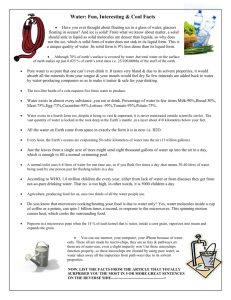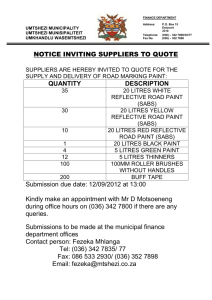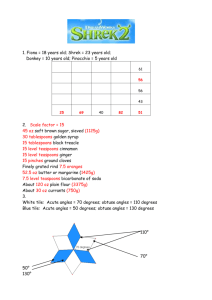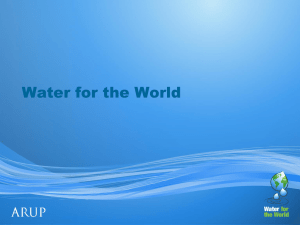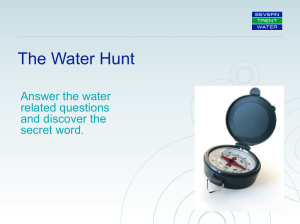msword - Royal Geographical Society
advertisement
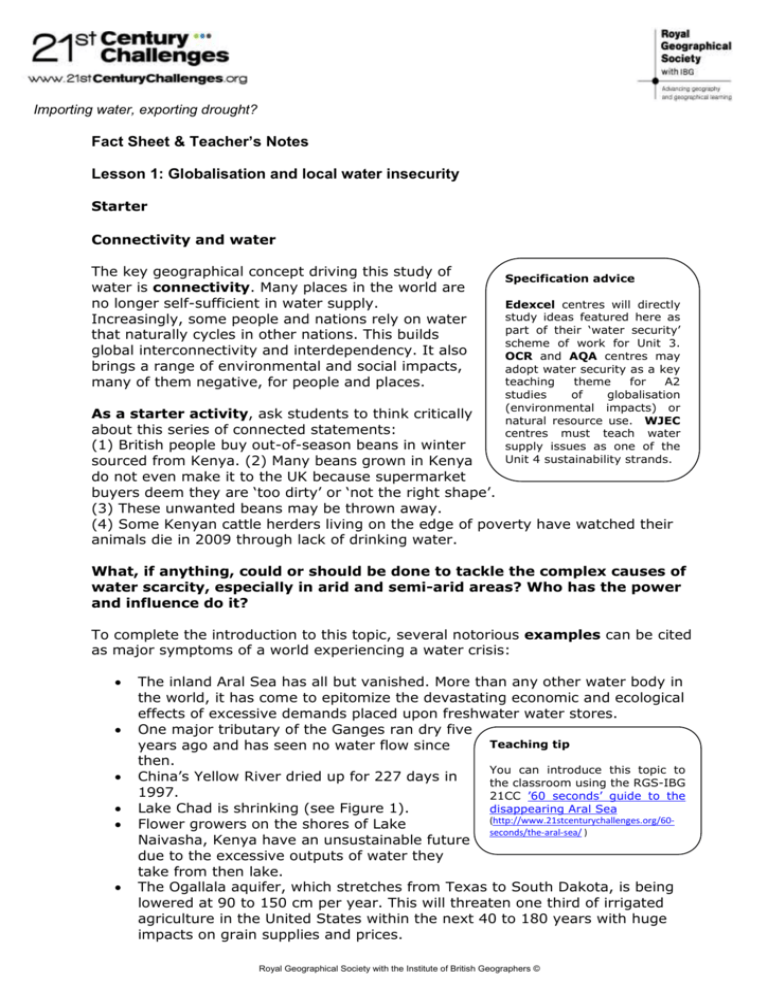
Importing water, exporting drought? Fact Sheet & Teacher’s Notes Lesson 1: Globalisation and local water insecurity Starter Connectivity and water The key geographical concept driving this study of water is connectivity. Many places in the world are no longer self-sufficient in water supply. Increasingly, some people and nations rely on water that naturally cycles in other nations. This builds global interconnectivity and interdependency. It also brings a range of environmental and social impacts, many of them negative, for people and places. Specification advice Edexcel centres will directly study ideas featured here as part of their ‘water security’ scheme of work for Unit 3. OCR and AQA centres may adopt water security as a key teaching theme for A2 studies of globalisation (environmental impacts) or natural resource use. WJEC centres must teach water supply issues as one of the Unit 4 sustainability strands. As a starter activity, ask students to think critically about this series of connected statements: (1) British people buy out-of-season beans in winter sourced from Kenya. (2) Many beans grown in Kenya do not even make it to the UK because supermarket buyers deem they are ‘too dirty’ or ‘not the right shape’. (3) These unwanted beans may be thrown away. (4) Some Kenyan cattle herders living on the edge of poverty have watched their animals die in 2009 through lack of drinking water. What, if anything, could or should be done to tackle the complex causes of water scarcity, especially in arid and semi-arid areas? Who has the power and influence do it? To complete the introduction to this topic, several notorious examples can be cited as major symptoms of a world experiencing a water crisis: The inland Aral Sea has all but vanished. More than any other water body in the world, it has come to epitomize the devastating economic and ecological effects of excessive demands placed upon freshwater water stores. One major tributary of the Ganges ran dry five Teaching tip years ago and has seen no water flow since then. You can introduce this topic to China’s Yellow River dried up for 227 days in the classroom using the RGS-IBG 1997. 21CC ’60 seconds’ guide to the Lake Chad is shrinking (see Figure 1). disappearing Aral Sea (http://www.21stcenturychallenges.org/60Flower growers on the shores of Lake seconds/the-aral-sea/ ) Naivasha, Kenya have an unsustainable future due to the excessive outputs of water they take from then lake. The Ogallala aquifer, which stretches from Texas to South Dakota, is being lowered at 90 to 150 cm per year. This will threaten one third of irrigated agriculture in the United States within the next 40 to 180 years with huge impacts on grain supplies and prices. Royal Geographical Society with the Institute of British Geographers © Figure 1 The disappearance of lake Chad (Reproduced with permission, citing author Philippe Rekacewicz, UNEP/GRID-Arendal. This collection of maps has been sourced from a series of satellite images provided by NASA Goddard Space Flight Center'; full URL for the graphic: http://maps.grida.no/go/graphic/lake-chad-decrease-in-area1963-1973-1987-1997-and-2001) Main activity (1) Causes of water insecurity and water stress The PDF article: ‘Water insecurity in a Global Context’ is to be used here. People living in areas such as these, where water availability is falling (especially if population is rising there too), are more likely to experience water insecurity and water stress than before. There are several reasons for increasing concerns with water security for people and places: Massive rising demand (on both local and global scales) from growing numbers of people, many of whom enjoy increasingly affluent lifestyles. The demand for water comes from a mixture of urban consumers, agricultural producers, industry and dams (for hydroelectric energy supply). In particular, food and drink producers place enormous demands on water supplies. Crop cultivation, crop processing, food distribution (and even the final recycling phase for food and drink packaging) all require water. Agriculturally-driven water stress is especially evident in the Indus river basin (which is home to the world’s largest irrigation system). Different diets have very different water demands. A meat and dairy diet may require 5,000 litres of virtual water per day; a vegetarian Key terms Water insecurity means people do not have adequate access to sufficient safe water to meet their human needs. Water stress is the term used when the annual supply of water directly available per person (not including ‘virtual water’) falls below 1,700 cumecs. Water scarcity is the term used when the annual supply of water directly available per person falls below 1,000 cumecs. Royal Geographical Society with the Institute of British Geographers © diet is much lower at 2,000 litres. This is because crops that could be directly consumed by humans are eaten by animals which themselves require additional water to meet their hydration and respiration needs. The physical factor of climate change is increasingly believed to be affecting rainfall and evaporation rates in ways that are further reducing water supplies in many places. Where there are multiple users in different countries, demand can be stretched further (19 Teaching tips countries make use of water taken from the River Danube). (1) As a GIS exercise, you can An interesting case study to explore is African-based beer brewer SAB Miller. The company is committed to reducing its overall water use, yet still uses 239 hectolitres of water annually. 1 litre of beer produced in its South African distillery requires inputs of 155 litres of water. 95% of this is used in the agricultural phase, growing the grain crops used in brewing (in Czech Republic, only 45 litres are required due to the cooler climate for agriculture). locate the Indus using Google Earth and make a study of the extent of irrigation systems within the catchment. (2) Watch the Head of Sustainable Development for SABMiller, Andy Wales, give his speech on the firm’s activities at the 21CC event. http://www.21stcenturychallenges.org/challen ges/importing-goods-exporting-drought/mediagallery/video/andy-wales-head-of-sustainabledevelopment-for-sabmiller/ (3) Watch Robin Farrington from WWF give his speech give his speech at the 21CC event. Table 1 shows the amount of water embedded in the production of a number of different common beverages. Table 1 http://www.21stcenturychallenges.org/challen ges/importing-goods-exporting-drought/mediagallery/video/robin-farrington-wwf/ Coffee Wine Apple juice Orange juice Beer Tea Bottled water 1100 960 950 840 300 130 5 Water needed to produce one litre of beverage (litres) Analysing the table Ask students to examine the range of values shown and suggest possible reasons for the differences. Answers might include the length of time the crop must be grown for as well as the nature of any processing that takes place and the likely water demands that are then made. Royal Geographical Society with the Institute of British Geographers © Main activity (2) The consequences of over-used water supplies A wide range of impacts on people and places can be studied. A good place to start researching impacts is World Wildlife Fund’s recent report on the water demands of overseas agriculture producing food and drink for consumption in the UK. Some key ideas for students to learn about include: Teaching tip You can study the findings of the World Wildlife Fund’s recent water usage report at: http://assets.panda.org/dow nloads/wwf_uk_footprint.pdf Saltwater incursion into areas where aquifers have been exhausted or groundwater levels lowered due to over-abstraction of water for agriculture. Biodiversity losses are experienced in many places due to lower river low: Yangtze River dolphins may now be extinct, for instance. According to WWF, one third of all vertebrate species live in or close to rivers and the massive species decline now underway worldwide owes much to shrinking freshwater supplies. Specification advice The Ebro delta makes a good case study for OCR students at AS level who are studying the management challenges for rivers and their landscapes. It can also be used by Edexcel A2 students investigating the geography of water supply and demand – looking especially at human factors affecting water availability and the key players involved in this. Spain’s Ebro delta is a useful case study for students to explore. Rising in the Cantabrian Mountains and flowing south for nearly one thousand kilometres into the Mediterranean Sea, the Ebro is the longest river in Spain, and has an extensive history of water management. Over the past 50 years, many dams have already been put in place, considerably reducing the level of silts carried by the river. Damage has been caused, in turn, to the Ebro Delta, a depositional landform that is dependent upon the continual arrival of new fluvial sediments. The Delta is a valuable agricultural area, and a nature reserve of international importance (it is one of the main staging posts for migratory birds moving between northern Africa and western Europe). Retreat of the delta has led to the partial loss of an important habitat for these transient species. Lower river discharge has also led to ‘salt wedge’ growth. Sea salt water began to penetrate further and further up into the river Ebro, as its flow was reduced during the Twentieth Century. Dam building and abstraction of water for agricultural, urban, industrial and energy use have all contributed to a lower discharge than in the past. As a result, heavier salt water now forms a wedge which drives upriver below the fresh water. This salt wedge regularly reaches Amposta, 25 km from the river mouth, thereby modifying the distribution patterns of fresh water fish and other organisms that cannot tolerate saline conditions. Royal Geographical Society with the Institute of British Geographers © Main activity (3) Understanding the importance of ‘virtual water’ The term virtual water describes the volume of water required to produce a product. For example: A can of cola contains 0.35 litres of water, yet it requires an average of 200 litres to grow and process the sugar contained in that can. It takes 2,900 litres to ‘grow’ a cotton shirt and 8,000 litres to produce a pair of leather shoes, i.e. the amount of water required to grow feed, support a cow, and process its skin into leather (all sources quoted in previously cited WWF report). As a result of virtual water, the average person living in the UK requires an amazing 4,600 litres of water today. If you are used to drinking just 4 or 5 litres a day this figure is certain to confuse you. The reason the virtual water figure is 1,000 times higher is because the calculation takes into account all of the water used to grow crops and raise animals over their lifetime to provide the meat and dairy products many of us eat each day. Factor in the water used by power stations and industrial processes and you can see how we end up with a much larger water footprint than just the water we drink as a liquid. Figure 2 shows the global network of interconnected places that supply the UK with its virtual water. The demands are vast. For the UK to be self-sufficient in food and drink, the entire nation would need to be converted to agricultural land use. Key terms Virtual water This is water that has been used in the production of food and goods, (it has been ‘embedded’). Water footprint (WF) This is the total virtual and visible water used to make food and products consumed by an individual, business, town, city or country. (A WF consists of two parts, the use of local water resources and the use of global water resources. Both parts include the use of blue water and green water.) Figure 2 The UK’s Agricultural Virtual Water Footprint (Source: WWF UK Water Footprint: the impact of the UK’s food and fibre consumption on global water resources Volume One) Royal Geographical Society with the Institute of British Geographers © Much of the food eaten by people living in the UK is grown there too, so a proportion of the country’s total water footprint affects its own rivers and wetlands. However, WWF’s analysis shows that this proportion amounts to only 38%. The UK is nowhere near selfsufficient in water: 62% of the total UK water footprint is accounted for by water from other nations. To calculate the UK’s actual water footprint of 4,600 litres per person, WWF analysed the water requirements of all agricultural products consumed. This included 503 crop (e.g. cotton, food, flowers) and 141 livestock products. Tables 2 shows some of their key findings about the UK’s water networks. Country Specification advice Virtual water is a relatively new concept that does not yet appear on any UK A-level Specifications. However, use of this term is sure to impress examiners, especially in the context of any discussion about resource use (OCR Unit 3) or sustainability (WJEC Unit 4). The concept is extremely geographical and may also be employed in a discussion of the environmental impacts of globalisation/ global networks (in both AQA Unit 4 and Edexcel Unit 1) % of EWF Major product categories (Mm3/yr) Brazil EWF (million m3/yr) 4,141 9 France 3,055 7 Ireland 2,828 6 Ghana 2,740 6 Beef (1,545), soybeans (1,431), coffee (418), poultry (104), livestock (309) Maize (1,045), rapeseed (325), wheat (280), swine (266), milk (209), sunflower (173) Beef (1,850), milk (423), swine (275), livestock (9,110), poultry (60), barley (42) Cocoa (2,676), groundnuts (22), oil palm fruit (6) India 2,317 5 Netherlands 2,083 4 Ivory Coast 1,826 4 Denmark 1,790 4 Indonesia 1,585 3 Spain 1,417 3 Germany 1,400 3 Cotton (1,206), rice (353), castor beans (262), tea (140),cashew nuts (86), groundnuts (61) Swine (961), livestock (217), poultry (161), beef (157) Cocoa (1,676), coffee (62), banana (44), oil palm fruit (13), cotton (11), cashew nuts (9) Swine (1,370), milk (221), livestock (81), beef (36), poultry (22), wheat (19) Oil palm fruit (989), coffee (206), cotton (115), tea (114), cocoa (79),coconuts (38) Olives (344), grapes (189), oranges (91), rice (90), swine (85), beef (85) Rapeseed (266), swine (235), milk (214), wheat (161), beef (149), livestock (145) Table 2 The top ten countries supporting the UK’s external agricultural water footprint (measured in million cubic metres /year) Analysing the table There are many questions for students to think about here, such as: What kinds of patterns emerge? Are products being sourced from near or far places? What crops are UK consumers especially dependent on imports of? What proportion of these products are meat or dairy? (meaning crops have in turn been consumed by animals) Royal Geographical Society with the Institute of British Geographers © Students could complete the ‘Globalisation and water insecurity assignment’ for homework. Plenary What’s in a tomato? As the largest provider of tomatoes to the UK, Spain represents 76% of Britain’s water footprint for this product. Here are some tomato facts to digest: Teaching tip Tomato cultivation covers over 60,000 ha. You can find out more about the The main producer regions include the Ebro hidden costs of embedded water: http://www.21stcenturychalleng valley and also the Guadiana valley. es.org/60-seconds/the-hiddenThe Canary Islands are one of the main cost-of-what-we-consume/ producers of fresh tomatoes. This short resource could also In Spain, tomato production alone serve as a useful lesson plenary. evaporates 297 million cumecs of water each year. On average, producing one tomato (assuming it to be equal to 100g) evaporates about 1.4 litres of green water and 6.1 litres of blue water, and pollutes nearly 0.7 litres of freshwater, totalling 8.2 litres per tomato. Royal Geographical Society with the Institute of British Geographers ©

